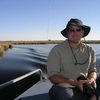[ __ /\´´´ ]
Eyjafjallajökull volcanic eruption, Markarfljót, South Iceland
April 19, 2010
On Wednesday morning the Eyjafjallajökull volcano started to erupt after a series of earthquakes underneath earlier that morning just one day after the Fimmvörduháls volcanic tissue-eruption site had been declared finished. Since then hot steam clouds created by explosive contact of hot air and lava with the ice had enough updraft to reach the tropopause, transporting volcanic ash over long distances with the westward wind drift towards Europe, shutting down all major air traffic for days. On the site, several serious floodings (glacial run-offs) from the melting water flooded the Markarfljót area, destroying parts of Iceland's main vital vein Route 1and leading to an evacuation of around 800 people. While the first flooding came from underneath and beside a glacier tongue, the others went over it and by that carved out deep valleys in the tongue itself. Big white crystalline ice boulders and a muddy mix of ash and soil could be found all over the Markarfljót area (~40 km²) for days.
This eruption is very different from the "tourist eruption" at Fimmvörduháls in the respect that it is about 10 times more powerful. Three craters developed along a long ridge at around one kilometre depth. Still, red coloured hot lava pieces reached the outside of the crater. One day after the eruption started, the air masses transported by the large scale atmospheric flow have been much drier and colder than before. Coinciding with a lot of friction due to the massive amount of ash in the outblast, flashes could be observed on a regular basis inside the ash cloud, leaving spectators with once in a lifetime moments of flashes, lava outblast, high turbulent clouds and strong ashfall on the leeward side of the mountain..
The picture is taken on the sixth day of the eruption. The cloud developed from the volcano is visibly smaller. Activity in the largest of the three craters is still unchanged while the other two slowed down. Ash fog like it can be found in sandstorms could be observed all around the mountain and made the documentation difficult for both technology and humans. The water level is considerably lower and the usual and new developed sandbanks are prominent.
unique video of lava explosions and shock waves:
http://http.ruv.straumar.is/static.ruv.is/vefur/20042010_myndir_omar.wmv
![[ __ /\´´´ ] [ __ /\´´´ ]](https://img.fotocommunity.com/b433ae96-62e9-404c-bc65-905b1725e78e.jpg?height=1080)










![[ __ /\´´´ ]](https://img.fotocommunity.com/b433ae96-62e9-404c-bc65-905b1725e78e.jpg?width=140&height=140)
Kathrin Martz 25/10/2010 22:59
superklasse!!lg kathrin
Markus A. Bissig 23/07/2010 17:06
Hallo MaikDurch Deine Anmerkung (Pneudruck ablassen auf Schneefelder…) komme ich zu Deinen Fotografien.
Feine Arbeiten sind da zu sehen!
Herzliche Grüsse aus Graubünden:
Markus
Polarfuchs 2 24/04/2010 19:07
Wunderschöne Aufnahme!Izzzy 23/04/2010 12:26
*Walter Eschgfäller 23/04/2010 11:33
wunderbares bild ...Nordfischer 23/04/2010 9:46
Was für ein geiles Nachtmotiv!! und schöne Aufnahme mit den Sternen!Fischergruß
Kay .,.~^~.,.~\______/~^~.,.~^~.,.~^~.
´¯`•.¸¸.•´¯`•.¸ >
`•.¸¸.•´¯`•.¸¸.•´¯`•.¸ >
Tom Riedel 22/04/2010 21:41
hammer!!!!!!!!!!!!!!!!!!!!!!!!!!!!!!!!!Anla 22/04/2010 20:54
So aus der Ferne....das ist wirklich schön, auch, daß man den Vg noch erkennt und der Himmel ist sowieso klasse....aber Dein schadenfroher Spruch....für mich war die Ruhe am Himmel auch ziemlich beauty, aber Viele haben das ganz anders gesehen....auch in Island, wenn ich den Bildern glauben darf, die ich gesehen habe !Dennoch finde ich diese lebendige Erde ganz toll...erzeugt Emotionen, die man sonst nicht hat....hoffend, daß nichts Schlimmeres passiert !
Gruß Anla
Annette He 22/04/2010 18:18
Sowas ist sowieso faszinierend. Besonders klasse finde ich hier die rote Spiegelung in der Wolke.LG Annette
Michael Krüger MK 22/04/2010 17:05
Super starke AufnahmeGruß Michael
Raymond Hoffmann 22/04/2010 11:38
hey Maik .... das kommt richtig gut, war eine schöne Nacht Vulkantour ;-)